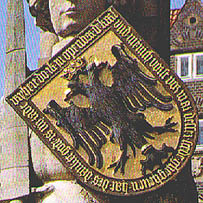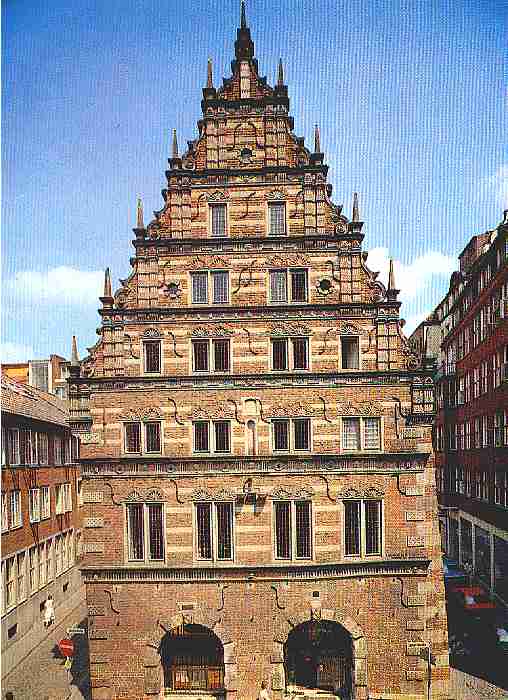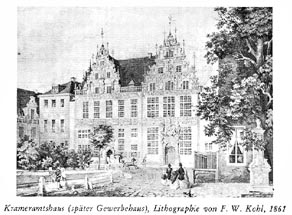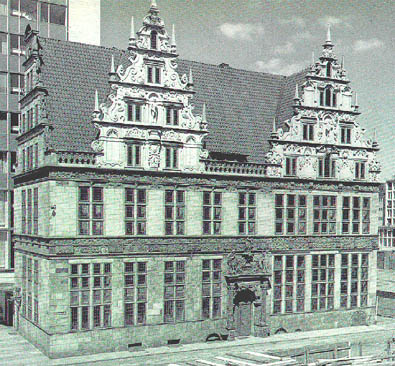The "Langenstraße" and the market place were the centre of the city of Bremen. This street led from the market to the "Schlachtpforte" and had than a continuation, which was called "Nadel" (needle). First the houses in the Langenstraße consisted of wood and wickerwork, but already in the 13th century were stone-buildings built.
In the 2nd World War the whole appearance of the Langenstraße radical changed, because the most houses were completly destroyed or badly damaged. In 1945 no building was unhurt any longer. So a complete reconstruction was necessary.
On the market place only the "Town Hall" beside the "Schütting" received as Renaissance-building. All the other buildings on the market place have only rests of Renaissance facades or are completly rebuilt.
Besides we find the "Stadtwaage" in the Langenstraße which is magnificent reconstructed. At the St. Ansgarihof (St. Ansgari Court) exists another original building of the Renaissance-style , das Gewerbehaus ("House of Trade").
In 1223 Bremen and Hamburg were controlled by the archbishop, who lived in Bremen. The citizen quarrelled with the church. They didn't like the arrogance and dictatorship of the church. As a special sign of their stubbornness against the church the church the citizen built the Roland on the marketplace facing the church.
The first wooden Roland was burned by the soldiers of the archbishop in 1366.
They thought that the destruction of the Roland had also destroyed the will of freedom of Bremen citizens. But in 1404 a new stoned Roland was built with a shiny sword. The Roland is a Symbol of power: he represents the right to trade and set up market and of jurisdiction. Everything on him has its own meaning: the gloves show the peace of market, the shiny sword in his hand demonstrates fairness and a lawful understanding of "Mine and Yours".
With his 5,45 metres he is a visible sign of the freed citizen of Bremen. As long as the Roland is standing - so people say- the freedom of the Bremen citizen is guaranteed.

In 965 the emperor Otto I. left the market-privilege of Bremen to the archbishop Adaldag and therewith to the church.
The city of Bremen wanted to be independent of the church and so the citizens set up the first wooden Roland in 1404.
The church wanted to keep its powerful position. That caused bad riots. There by the new symbol of Bremen was burned down. But the citizens didn´t give up and so they built a new Roland, 5 metres tall, that was made of stone.
And in the case the head of the church had evil in mind, the citizens had another Roland prepared.
Still today the Roland is situated on the market-place as a symbol of freedom of Bremen.
The "Schütting"
"Schütting" was rebuilt in 1536 and is situated up to now on the market place of Bremen. The name "Schütting" derives from the German verb "zusammenschütten"; because all the money was "thrown together" (money, duties and other finances). That quite big building was mainly used for representative occasions. But soon it didn´t suffice any longer to the pretensions of the noblemen and the merchants; and so they ordered to rebuild it. The slogan of the house was and is "buten und binnen, wagen und winnen" and means "outside and inside, to risk and to win".
This house, that is built in the Renaissance-style, is decorated with "Putten". Putten are figures which are chiseled of stone. They embody the colourful market of Bremen on the foots of the "Schütting" and they never express anything negative. The material is sandstone and found at the "Oberweser". On the side of the "Schütting" are wonderful gablestairs, which were reconstructed in the Renaissance-style after the 2nd World War.
The "Schütting" represents the flandric trend of the Renaissance.
1536-1538 Installation with nine axles built by Johann Buscheneer from Antwerpen.
1565 The gable to the "Schüttingstraße" constructed by Carsten Husmann.
1594 The small central gable and the balustrade on the front of the market.
1849 The Schütting doesn´t belong any longer to the guild of the merchants, the building is transfered to the new etablished "Handwerkskammer" (Chamber of Commerce).
Destruction of the "Schütting" by bombers during the 2nd World War.
1947-1955 Ernst Erhart reconstructed the "Schütting", based on the original from 1594 (facade to the market place), 1565 (gables to the Schüttingstraße), 1538 (gables to the Langenstraße).
The "Langenstraße" was the most important street of trade in Bremen. To it belonged "The Stadtwaage". Like by an exchange in "The Stadtwaage" met all people who did buisness already in the 14th century. Everything what ought to be sold was done the "Stadtwaage". Weighting was so important because there weren´t constant weights yet. Weighting meaned control and the burial of constant weights. So mattered in Bremen for example that one ton of butter had to weight 300 pound. Strangers had to pay for weighting of things a tax of two Groten (that was a currency), citizens of Bremen had to pay the half price.
In 1587 the house was started to build, Lüder von Bentheim (look at the Town Hall of Bremen) was the architect. The gable side of the Stadtwaage was constructed in the style of the Weserrenaissance.
The weighting was in the big hall on the ground floor. But the "Stadtwaage" was also a warehouse. Above the big hall were further floors to stack up the goods. These floors were used in parts as a festival- and assemblyroom.
So that in the 19th century more and more dealers had their own weights, the public "Stadtwaage" became superfluous.
Since 1877 were in it the inland revenue office and the land registry office. Since 1925 the new established "Radio Bremen" used this house. At the end of the Second World War the "Stadtwaage" was a bombed-out ruin, a reconstruction seemed impossible.
But from 1958 till 1961 the "Sparkasse of Bremen" reconstructed the house.
From that time the "Stadtwaage" could be used for several purposes. On the ground floor we find an office of the "Sparkasse of Bremen" and on the upper floor was installed a celebration hall for cultural events.

The "Gewerbehaus" (The House of Trade)
The "Gewerbehaus" was built by Johann Nache in 1618 and is situated in the "Obernstraße". It was mainly used as an office, a marriage-house and a house were they tasted many delicious meals. In 1619 it consisted of two seperate houses. Until 1861 it was private and later on it belonged to the city of Bremen. One year later it was reconstructed by Simon Loscher to the "House of Trade". Just like the "Schütting" it was badly damaged by bombers during the 2nd World War. The damaged gable couldn’t be reconstructed again. As a makeshift the architects took the Renaissance-gable of the "Wissenberg House", wich was damaged, too, and adjustet it to the ground-plan of the "House of Trade".


But in Bremen there aren’t only whole renaissance buildings, but also new buildings, wich were reconstructed again with fragments of the bombed-out houses. For example the "Ratsapotheke" (Council Pharmacy), which was reconstructed in Renaissance style from 1909 till 1912 by Rudof Jakobs.
We find some other Renaissance pieces from different buildings on the market place, in the "Langenstraße" and at the "Roselius Haus" in the "Böttcherstraße".